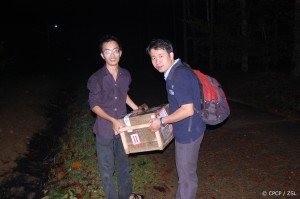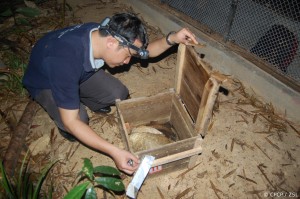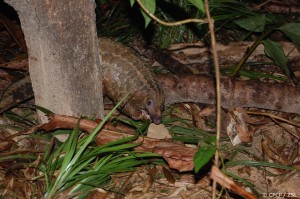It’s a very exciting time in Vietnam! After being confiscated from the wildlife trade in 2010, the first of the Sunda pangolins held at the Carnivore and Pangolins Conservation Program (CPCP) has been released into Cat Tien National Park. EDGE Fellow Phuong, tells us more…

Earlier this month, we moved the first pangolin to be released to the soft release enclosure in Cat Tien National Park and she’s spent the last month acclimatizing to her new surroundings whilst we carefully monitored for any stress behaviors (e.g. pacing, not eating and climbing on the wire meshing of the cage).
And then this week it happened! Our first pangolin was been released into Cat Tien National Park and we were ecstatic! But what is it about this endangered species that means a release programme should be considered as a management option for conserving this species?

Secondly, Sunda pangolins are adaptable animals and can survive in most habitats. It is a diet generalist (feeding on several different species of termite and ant each night) and known to be both arboreal (in the canopy) and ground dwelling (in tree hollows or underground burrows) in their sleeping habits. These ecological requirements can be met in relatively small areas in a number of different habitat types. Therefore, theoretically, there should be an abundance of potential release sites within its geographical range.
Finally, there is a severe lack of awareness regarding the plight of pangolins. A release project like this provides the opportunity to help address this problem and begin to stimulate an attitudinal change towards the trade of pangolins.
On paper, a release may seem like a fairly straight forward procedure. In reality, hunting pressures and habitat degradation and destruction make finding suitable sites harder than it should be; and the susceptibility of Sunda pangolins to stress makes rehabilitation a difficult 
It is this gentle approach and attention to proper preparation that gives the animals the best possible opportunity to survive and positively impact on the conservation of the Sunda pangolin. In the weeks to come, we will track our released pangolin (using the radio transmitting device that has been attached to its scales) and I look forward to updating you on its adventures!
You can watch film footage of the release here: https://www.facebook.com/photo.php?v=3030281773895&set=vb.199134146807749&type=2&theater and learn more about Phuong’s project on his community page.